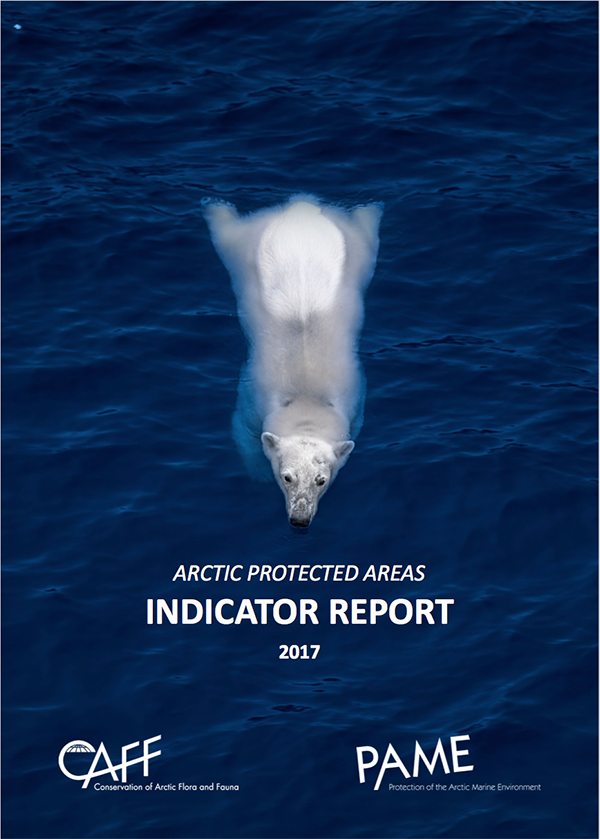…says new report released at Arctic Council Ministerial
To download the report and get more information: www.arcticbiodiversity.is/marine | www.pame.is
All the data collected for this report can be found on CAFFs Arctic Biodiversity Data Service (ABDS)

On May 11th 2017, the Conservation of Arctic Flora and Fauna (CAFF) released the Arctic Protected Areas Indicator Report, which was generated via the Circumpolar Biodiversity Monitoring Program (CBMP), GEO BON’s Arctic BON.
The Arctic Protected Areas Indicator Report catalogues the extent of protected areas across the Arctic and the trends in protected area establishment.
The report states that protected areas in the Arctic have doubled since 1980, with 4.6% of the marine and 20.2% of the terrestrial environment, or 11.4% of the total Arctic (3.7 million km2) achieving protected areas status under the International Union for Conservation of Nature (IUCN) categories. The UN Aichi Biodiversity Target is to, by 2020, conserve 17% of terrestrial and inland water and to conserve 10% of coastal and marine areas by the same year.
Ninety-two areas recognised under global international conventions are found in the Arctic. These include 12 World Heritage sites and 80 Ramsar (wetland) sites, which together cover 289,931 km2 (0.9% of the Arctic). Between 1985 and 2015, the total area covered by Ramsar sites almost doubled, while the total area designated as World Heritage sites increased by about 50% in the same period.
In 2013 the Arctic Council identified 98 “areas of heightened ecological and cultural significance” covering a vast area of about 14 million km2, via the Arctic Marine Shipping Assessment process. Approximately 5% of those 98 lie within protected areas according to the new report.
This report is part of a suite of indices and indicators developed by CAFF´s Circumpolar Biodiversity Monitoring Program (CBMP) to provide a comprehensive picture of the state of Arctic biodiversity.
Contacts:
| Courtney Price Communications Manager courtney@caff.is +354 821 3609 |
Tom Barry CAFF Executive Secretary tom@caff.is +354 861 9824 |
Soffia Guðmundsdóttir PAME Executive Secretary soffia@pame.is +354 863 8576 |
Conservation of Arctic Flora and Fauna
CAFF is the biodiversity working group of the Arctic Council and consists of National Representatives assigned by each of the eight Arctic Council Member States, representatives of Indigenous Peoples’ organizations that are Permanent Participants to the Council, and Arctic Council observer countries and organizations. CAFF’s mandate is to address the conservation of Arctic biodiversity, and to communicate its findings to the governments and residents of the Arctic, helping to promote practices which ensure the sustainability of the Arctic’s living resources. For more information: www.caff.is
Protection of the Arctic Marine Environment (PAME)
PAME is responsible for Arctic Council’s activities related to the protection and sustainable use of the Arctic marine environment. PAME consists of National Representatives assigned by each of the eight Arctic Council Member States, representatives of Indigenous Peoples’ organizations that are Permanent Participants to the Council, and Arctic Council observer countries and organizations. PAME’s mandate is to address marine policy and non-emergency pollution prevention control measures related to the conservation and sustainable use of the Arctic marine and coastal environment in response to environmental change and from both land and sea-based activities. For more information: www.pame.is
Arctic Council
The Arctic Council is a high level intergovernmental forum to provide a means for promoting cooperation, coordination and interaction among the Arctic States, with the involvement of the Arctic Indigenous communities and other Arctic inhabitants on common Arctic issues, in particular issues of sustainable development and environmental protection in the Arctic. Arctic Council Member States are Canada, Denmark (including Greenland and the Faroe Islands), Finland, Iceland, Norway, Russian Federation, Sweden, and the United States of America. In addition to the Member States, the Arctic Council has the category of Permanent Participants who include the Arctic Athabaskan Council (AAC), Aleut International Association (AIA), Gwich’in Council International (GGI), Inuit Circumpolar Council (ICC), Russian Association of Indigenous Peoples of the North (RAIPON) and the Saami Council (SC). For more information: www.arctic-council.org
Aichi Targets
The Aichi Biodiversity Targets are a set of 20 Targets grouped into five Strategic Goals for achievement by 2020. They are part of the Strategic Plan for Biodiversity 2011-2020, which was adopted in 2010 by the 10th Meeting of the Conference of Parties of the United Nations Convention on Biological Diversity (CBD). Addressing aspects of sustainable development, they range from reducing direct pressure on biodiversity and mainstreaming nature across different sectors, to promoting sustainable use and providing benefits to all from the use of biodiversity and ecosystem services.
Definiton of the Arctic
There is no single agreed-upon definition of the Arctic; however, for the purpose of this indicator report, the CAFF boundary is used to define the geographical extent of the Arctic. This covers 32.2 million km2, 57% (18.4 million km2) of which is marine and 43% (14 million km2) terrestrial. It is important to note that some boreal forest is included within the CAFF boundary and is therefore included in the calculations presented in this report.
